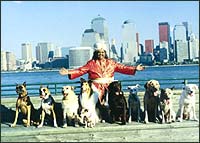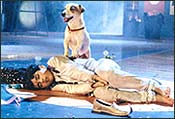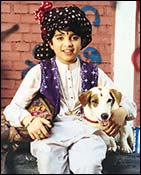Home > Movies > Interviews
'I expect the film to be a huge hit'
Shobha Warrier |
April 03, 2003 22:05 IST
Navodaya producer Appachan made history by making India's first 3-D film, My Dear Kuttichattan (the Hindi version was called Ch hota Chetan) 20 years ago. The film was directed by Appachan's elder son, Jijo.
hota Chetan) 20 years ago. The film was directed by Appachan's elder son, Jijo.
His second son, Jose Punnoose, now directs another 3-D film Magic, Magic (in Hindi).
The film stars Suraj Balajee (whose performance in Shah Rukh Khan's Asoka was much appreciated) and singer-actor S P Balasubramaniam in the main roles. Seventy per cent of the film was shot in the United States.
Jose claims Magic, Magic will be a summer treat for kids and families. The Tamil version of the film will release April 4, the Malayalam version April 9, the Hindi and Telugu version on April 11.
In all, Magic, Magic will release in at least a hundred theatres all over India during April and May, Punnoose tells Shobha Warrier:
How did the director's mantle fall on you?
Frankly, this film came to me on the rebound. I was a production guy till now. My brother, who is the technical person, took care of direction. I had no choice but to manage production. But I was good at concepts. Except for this creative output, I was never involved in the execution of a film.
This is my 23rd year in the industry. This venture started 18 years ago. I sent my scriptwriter to the US for a month, but the film never began. Our priorities were different then. I tried to revive it in 1996 but failed. I tried again in 2000 and this is the result.
Were you to direct the film when you revived the project?
No. I was the person behind the concept; I was the person pushing people. The reason I directed the film was personal. I had offered the project to a director but he said it was not his forte.
I must admit I wouldn't have done this if not for the help I received from the people whom I had supported earlier. All of them backed me and promised to help me.
Did you look at My Dear Kuttichattan for reference or is everything about Magic, Magic fresh?
No. What motivates me is the story or the concept.
The 3-D angle came in much later. That was not what I had in mind 20 years ago. Once the magician's character was thrown in, we thought it had to be a 3-D film.
How difficult is it shooting a 3-D film?
Quite difficult. But, since we had made a 3-D movie earlier, it was slightly easier. It takes longer to execute a 3-D film than a normal one. It is more expensive too.
If you are working with 100 kilowatts of light for an ordinary film, a 3-D film needs at least 350 kilowatts of light. Then comes the question of time. Lighting takes at least four times more time and that costs money, too.
It took us about 140 days to shoot, when we would have normally finished in it 40 or 50 days.
Who took care of the technical aspects of the film?
Nambyadiri handles the 3-D part of the film. He works as a cameraman in Malayalam and Tamil films. We trained him 20 years ago on 3-D filmmaking. For the US shoot, the main crew was from India, but the support crew was from the US.
Why do you have a US angle in the story?
My original idea was about an Indian kid who is taken to the US against his wishes by his father.
In a family of magicians, an offspring refuses to learn magic. He believes in the magic of the West and decides to move there. Just before leaving, he loses his wife and has to leave his small son (Suraj Balajee) with his father (S P Balasubramaniam). The father takes this opportunity to revive the tradition the family had been following for generations.
The film starts with the father coming back to India from the US to visit his son. He finds the kid has been brought up as a magician without any basic education. Upset, he takes the child to the US, away from his grandfather. The boy is totally out of place there. He runs away from home to come back to his grandfather and, in the process, meets a street dog. That is when their adventures start.
I thought of the US because I wanted the child to be in a place where he would be totally lost. It is li ke throwing a kid into water. You have an Indian kid who does not know English alone in the streets of America. Seventy per cent of the shooting took place in New York City. The element of magic was thrown in to give it a touch of fantasy.
ke throwing a kid into water. You have an Indian kid who does not know English alone in the streets of America. Seventy per cent of the shooting took place in New York City. The element of magic was thrown in to give it a touch of fantasy.
How did you feel once you finished shooting the film?
As this is a 3-D film, my work did not end with the shooting. The toughest part is projecting the film in the theatres. We have to install a new, special, silver-coated screen in every theatre. We made these screens ourselves. After importing the material from the US, we made the glasses needed to view the film. We have made over a million glasses to be supplied all over the country.
We also imported special 3-D projection lenses from Germany, which we have to install in all the theatres screening the film. Installing this lens takes at least 10 hours. We have a team that will go to the various theatres to do this.
The most difficult part is changing the screens and lenses in the theatres overnight.
We have to employ at least 20 people in all the theatres to distribute the glasses, collect them after the show, sterilise them, etc. After two weeks, we have to change the glasses.
Altogether, the film will cost us Rs 14 crores (Rs 140 million). I expect the film to be a huge hit.